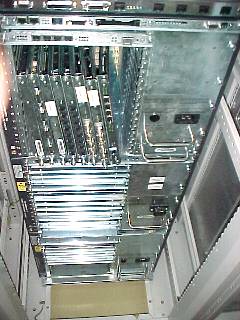The MAX TNT is a really big and heavy chassis
with up to 672 (DS3) / 960 (E1) data modem sessions per chassis. It can handle ATM, Voice Over IP and Frame Relay and more.
It is based an a multiprocessor technology, having allmost unlimited resources. Up to 3 MAX TNT´s can be daisy chained to a trunk of abnormous giantic size.
The MAX TNT was planned in 1995 to 1996. The first shelf controller boards have a design date from 1996 with board # 1100-0402-002 Rev A. If you know, that the first 3 digits are the production date, you see = SN 848-600386 was from week 48 of 1998. This was assy # 1300-0402-001 Rev R.
This section here was to inform you about any kind of reference, your board is from. The follow up product from Lucent is (or was - you never know) the APX 8000 series.
Sunshine and rain in one box . . . .
The first revisions of the TNTs have some easily detected and really bad shelf-board modifications. Please notice, we are talking about a 250.000 dollars ( two hundred and fifty thousand dollars = quarter of a million) product. Its not a pipeline.
Opening the cover of the shelf controler module, we were disappointed (negatively suprised) about the quality of design and manufacturing. May be the following revisions are built better.
Getting 30 TNTs in 2005, we can say: Yes they are.
Keep of hands from MAX TNTs older than 1999. There are a few reasons only to buy such old units.
Looking to the components, your see a serial EEPROM, two flash modules 28F008, the 50 MHz I960, a little Lithium battery, some onboard RAM and two PCMCIA slots.
The very top module of the first MAX TNT on the above picture shows a 1 port 100 MBit and 3 port 10 Mbit Ethernet card.
This module is designed to handle 100 Mbit input to give the MAX TNT the needed power to talk to a Radius server and the backbone with full power for up to 960 ISDN channels. And it opens a lot possibilities to route and connect different other wan networks.



